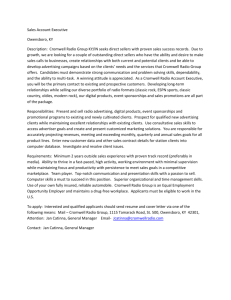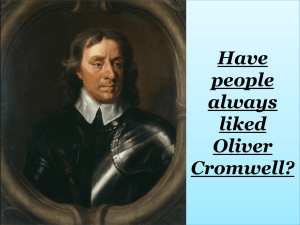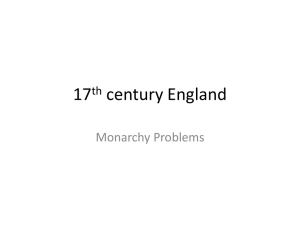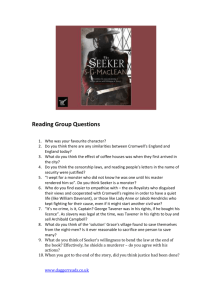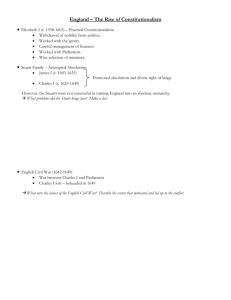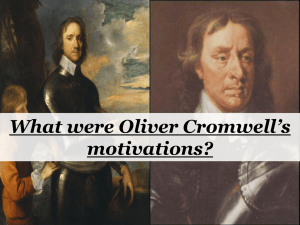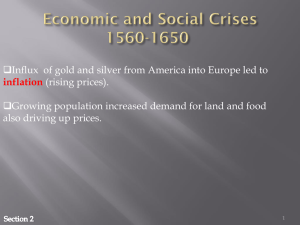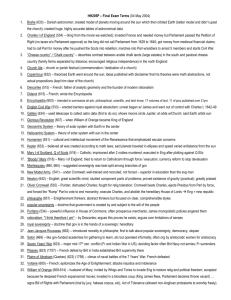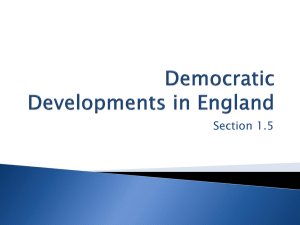Oliver Cromwell and the Civil War
advertisement
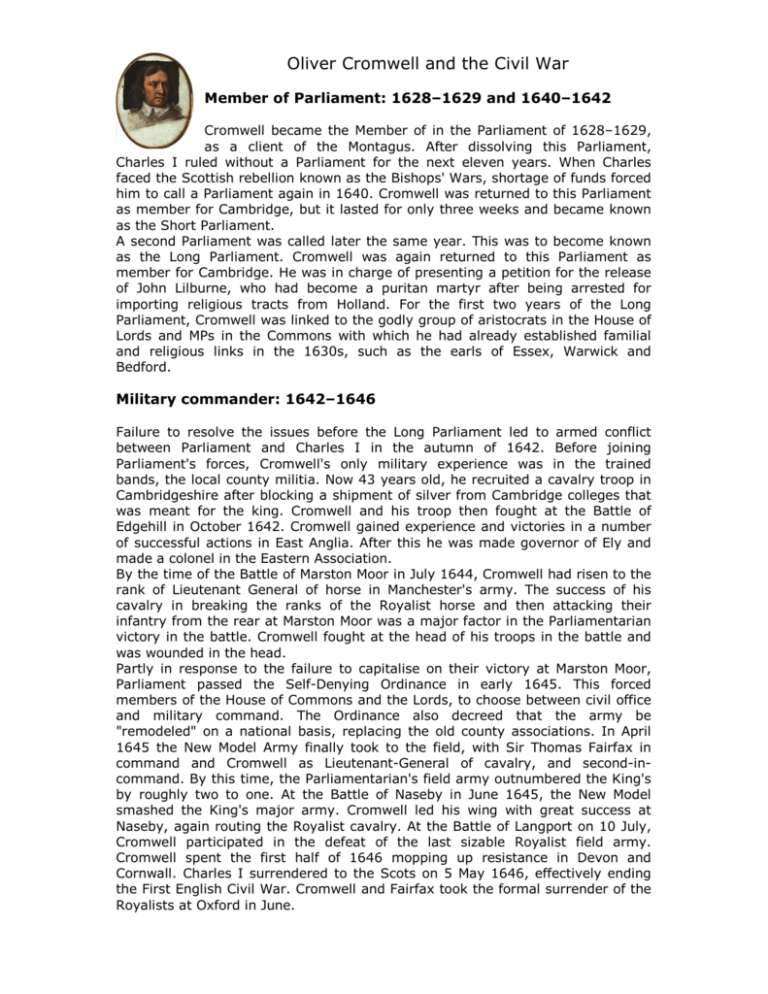
Oliver Cromwell and the Civil War Member of Parliament: 1628–1629 and 1640–1642 Cromwell became the Member of in the Parliament of 1628–1629, as a client of the Montagus. After dissolving this Parliament, Charles I ruled without a Parliament for the next eleven years. When Charles faced the Scottish rebellion known as the Bishops' Wars, shortage of funds forced him to call a Parliament again in 1640. Cromwell was returned to this Parliament as member for Cambridge, but it lasted for only three weeks and became known as the Short Parliament. A second Parliament was called later the same year. This was to become known as the Long Parliament. Cromwell was again returned to this Parliament as member for Cambridge. He was in charge of presenting a petition for the release of John Lilburne, who had become a puritan martyr after being arrested for importing religious tracts from Holland. For the first two years of the Long Parliament, Cromwell was linked to the godly group of aristocrats in the House of Lords and MPs in the Commons with which he had already established familial and religious links in the 1630s, such as the earls of Essex, Warwick and Bedford. Military commander: 1642–1646 Failure to resolve the issues before the Long Parliament led to armed conflict between Parliament and Charles I in the autumn of 1642. Before joining Parliament's forces, Cromwell's only military experience was in the trained bands, the local county militia. Now 43 years old, he recruited a cavalry troop in Cambridgeshire after blocking a shipment of silver from Cambridge colleges that was meant for the king. Cromwell and his troop then fought at the Battle of Edgehill in October 1642. Cromwell gained experience and victories in a number of successful actions in East Anglia. After this he was made governor of Ely and made a colonel in the Eastern Association. By the time of the Battle of Marston Moor in July 1644, Cromwell had risen to the rank of Lieutenant General of horse in Manchester's army. The success of his cavalry in breaking the ranks of the Royalist horse and then attacking their infantry from the rear at Marston Moor was a major factor in the Parliamentarian victory in the battle. Cromwell fought at the head of his troops in the battle and was wounded in the head. Partly in response to the failure to capitalise on their victory at Marston Moor, Parliament passed the Self-Denying Ordinance in early 1645. This forced members of the House of Commons and the Lords, to choose between civil office and military command. The Ordinance also decreed that the army be "remodeled" on a national basis, replacing the old county associations. In April 1645 the New Model Army finally took to the field, with Sir Thomas Fairfax in command and Cromwell as Lieutenant-General of cavalry, and second-incommand. By this time, the Parliamentarian's field army outnumbered the King's by roughly two to one. At the Battle of Naseby in June 1645, the New Model smashed the King's major army. Cromwell led his wing with great success at Naseby, again routing the Royalist cavalry. At the Battle of Langport on 10 July, Cromwell participated in the defeat of the last sizable Royalist field army. Cromwell spent the first half of 1646 mopping up resistance in Devon and Cornwall. Charles I surrendered to the Scots on 5 May 1646, effectively ending the First English Civil War. Cromwell and Fairfax took the formal surrender of the Royalists at Oxford in June. Politics: 1647–1649 In February 1647 Cromwell suffered from an illness that kept him out of political life for over a month. By the time of his recovery, the Parliamentarians were split over the issue of the king. A majority in both Houses pushed for a settlement that would pay off the Scottish army, disband much of the New Model Army, and restore Charles I in return for a Presbyterian settlement of the Church. Cromwell rejected the Scottish model of Presbyterianism, which threatened to replace one authoritarian hierarchy with another. The New Model Army, radicalised by the failure of the Parliament to pay the wages it was owed, petitioned against these changes, but the Commons declared the petition unlawful. During May 1647, Cromwell was sent to the army's headquarters to negotiate with them, but failed to reach agreement. In June 1647, a troop of cavalry under Cornet George Joyce seized the king from Parliament's imprisonment. Cromwell and Henry Ireton then drafted a manifesto — the "Heads of Proposals" — designed to check the powers of the executive, set up regularly elected parliaments, and restore a non-compulsory Episcopalian settlement. Many in the army, such as the Levellers led by John Lilburne, thought this was insufficient demanding full political equality for all men, leading to tense debates during the autumn of 1647 between Cromwell, Ireton and the army. The debates, and the escape of Charles I from Hampton Court on 12 November, are likely to have hardened Cromwell's resolve against the king. The failure to conclude a political agreement with the king eventually led to the outbreak of the Second English Civil War in 1648, when the King tried to regain power by force of arms. Cromwell marched north to deal with a pro-Royalist Scottish army who had invaded England. At Preston, Cromwell, in sole command for the first time with an army of 9,000, won a brilliant victory against an army twice that size. For Cromwell, the army was now God's chosen instrument In December 1648, those MPs who wished to continue negotiations with the king were prevented from sitting by a troop of soldiers headed by Colonel Thomas Pride, an episode soon to be known as Pride's Purge. Those remaining, known as the Rump Parliament, agreed that Charles should be tried on a charge of treason. Cromwell was still in the north of England, dealing with Royalist resistance when these events took place. However, after he returned to London, on the day after Pride's Purge, he became a determined supporter of those pushing for the king's trial and execution. He believed that killing Charles was the only way to bring the civil wars to an end. The death warrant for Charles was eventually signed by 59 of the trying court's members, including Cromwell (who was the third to sign it). Charles was executed on 30 January 1649. Establishment of the Commonwealth: 1649 After the execution of the King, a republic was declared, known as the Commonwealth of England. The Rump Parliament exercised both executive and legislative powers, with a smaller Council of State also having some executive functions. Cromwell remained a member of the Rump and was appointed a member of the Council. In the early months after the execution of Charles I, Cromwell tried but failed to unite the original group of 'Royal Independents' centred around St John and Saye and Sele, which had fractured during 1648. Cromwell had been connected to this group since before the outbreak of war in 1642 and had been closely associated with them during the 1640s. However only St John was persuaded to retain his seat in Parliament. The Royalists, meanwhile, had regrouped in Ireland, having signed a treaty with the Irish Confederate Catholics. In March, Cromwell was chosen by the Rump to command a campaign against them. Irish Campaign: 1649–50 Cromwell led a Parliamentary invasion of Ireland from 1649–50. Parliament's key opposition was the military threat posed by the alliance of the Irish Confederate Catholics and English royalists (signed in 1649). The Confederate-Royalist alliance was judged to be the biggest single threat facing the Commonwealth. Cromwell's hostility to the Irish was religious as well as political. He was passionately opposed to the Roman Catholic Church, which he saw as denying the primacy of the Bible in favour of papal and clerical authority, and which he blamed for tyranny and persecution of Protestants in Europe. Cromwell's association of Catholicism with persecution was deepened with the Irish Rebellion of 1641. This rebellion was marked by massacres of English and Scottish Protestant settlers by native Irish Catholics in. Parliament had planned to re-conquer Ireland since 1641 and had already sent an invasion force there in 1647. Cromwell's invasion of 1649 was much larger and, with the civil war in England over, could be regularly reinforced and resupplied. His nine month military campaign was brief and effective, though it did not end the war in Ireland. One of his major victories in Ireland was diplomatic rather than military. With the help of Roger Boyle, 1st Earl of Orrery, Cromwell persuaded the Protestant Royalist troops in Cork to change sides and fight with the Parliament. At this point, word reached Cromwell that Charles II had landed in Scotland and been proclaimed king by the Covenanter regime. Cromwell therefore returned to England from Youghal on 26 May 1650 to counter this threat. Scottish Campaign: 1650–1651 Cromwell left Ireland in May 1650 and several months later, invaded Scotland after the Scots had proclaimed Charles I's son as Charles II. Cromwell was much less hostile to Scottish Presbyterians, some of whom had been his allies in the First English Civil War, than he was to Irish Catholics. He described the Scots as "a people fearing His [God's] name, though deceived". He made a famous appeal to the General Assembly of the Church of Scotland, urging them to see the error of the royal alliance. His appeal rejected, Cromwell's veteran troops went on to invade Scotland. Cromwell smashed the main army at the Battle of Dunbar, killing 4,000 Scottish soldiers, taking another 10,000 prisoner and then capturing the Scottish capital of Edinburgh. The following year, Charles II and his Scottish allies made a desperate attempt to invade England and capture London while Cromwell was engaged in Scotland. Cromwell followed them south and destroyed the last major Scottish Royalist army. Return to England and dissolution of the Rump Parliament: 1651-53 From the middle of 1649 until 1651, Cromwell was away on campaign. In the meantime, with the king gone (and with him their common cause), the various factions in Parliament began to engage in infighting. On his return, Cromwell tried to galvanise the Rump into setting dates for new elections, uniting the three kingdoms under one polity, and to put in place a broad-brush, tolerant national church. However, on 20 April 1653, supported by about forty musketeers, he cleared the chamber and dissolved the Parliament by force. Several accounts exist of this incident: in one, Cromwell is supposed to have said "you are no Cromwell dissolving the Rump Parliament. Parliament, I say you are no Parliament; I will put an end to your sitting". At least two accounts agree that Cromwell snatched up the mace, symbol of Parliament's power, and demanded that the "bauble" be taken away. The establishment of Barebones Parliament: 1653 After the dissolution of the Rump, power passed temporarily to a council that debated what form the constitution should take. Sometimes known as the Parliament of Saints or more commonly the Nominated Assembly, it was also called the Barebone's Parliament after one of its members, Praise-God Barebone. The assembly was tasked with finding a permanent constitutional and religious settlement (Cromwell was invited to be a member but declined). The Protectorate: 1653-1658 It made Cromwell Lord Protector for life to undertake “the chief magistracy and the administration of government”. Cromwell was sworn in as Lord Protector on 16 December 1653, with a ceremony in which he wore plain black clothing, rather than any monarchical regalia. As Protector, he had the power to call and dissolve parliaments but was obliged under the Instrument to seek the majority vote of a Council of State. Cromwell had two key objectives as Lord Protector. The first was "healing and settling" the nation after the chaos of the civil wars and the regicide, which meant establishing a stable form for the new government to take. Cromwell declared, "A nobleman, a gentleman, a yeoman; the distinction of these: that is a good interest of the nation, and a great one.” In 1657, Cromwell was offered the crown by Parliament as part of a revised constitutional settlement, presenting him with a dilemma, since he had been "instrumental" in abolishing the monarchy. Cromwell agonised for six weeks over the offer. He was attracted by the prospect of stability it held out, but in a speech on 13 April 1657 he made clear that God's providence had spoken against the office of king. Instead, Cromwell was ceremonially re-installed as Lord Protector on 26 June 1657 (with greater powers than had previously been granted him under this title) at Westminster Hall, sitting upon King Edward's Chair which was specially moved from Westminster Abbey for the occasion. Oliver Cromwell died at Whitehall on Friday 3 September 1658, the anniversary of his great victories at Dunbar and Worcester. He was buried with great ceremony, with an elaborate funeral based on that of James I, at Westminster Abbey, his daughter Elizabeth also being buried there. Summary Oliver Cromwell (25 April 1599 Old Style – 3 September 1658 Old Style) was an English military and political leader best known for his involvement in making England into a republican Commonwealth and for his later role as Lord Protector of England, Scotland and Ireland. He was one of the commanders of the New Model Army which defeated the royalists in the English Civil War. After the execution of King Charles I in 1649, Cromwell dominated the short-lived Commonwealth of England, conquered Ireland and Scotland, and ruled as Lord Protector from 1653 until his death in 1658. Cromwell was born into the ranks of the middle gentry, and remained relatively obscure for the first 40 years of his life, at times his lifestyle resembling that of a yeoman farmer until his finances were boosted thanks to an inheritance from his uncle. After undergoing a religious conversion during the same decade, he made an Independent style of Puritanism a core tenet of his life. Cromwell was elected Member of Parliament (MP) for Cambridge in the Short (1640) and Long (164049) Parliaments, and later entered the English Civil War on the side of the "Roundheads" or Parliamentarians. An effective soldier (nicknamed "Old Ironsides") he rose from leading a single cavalry troop to command of the entire army. Cromwell was the third person to sign Charles I's death warrant in 1649 and was an MP in the Rump Parliament (1649-1653), being chosen by the Rump to take command of the English campaign in Ireland during 1649-50. He then led a campaign against the Scottish army between 1650-51. On 20 April 1653 he dismissed the Rump Parliament by force, setting up a short-lived nominated assembly known as the Barebones Parliament before being made Lord Protector of England, Scotland, and Ireland on 16 December 1653 until his death.

